Brown spiders are found in many places in Utah, and they all help balance the ecosystem. They help control insect populations, which can be beneficial to humans. No matter how terrifying these arachnids look, it’s no secret that they play a huge role in the environment. Whether you want to learn more about them or you simply want to know how to identify the dangerous ones, It’s always a good idea to get to know the common spiders in your area. In Utah, there are many brown spiders. Here are just 10 of the brown spiders you may come across in Utah.
The Spitting Spider (Scytodes thoracica)
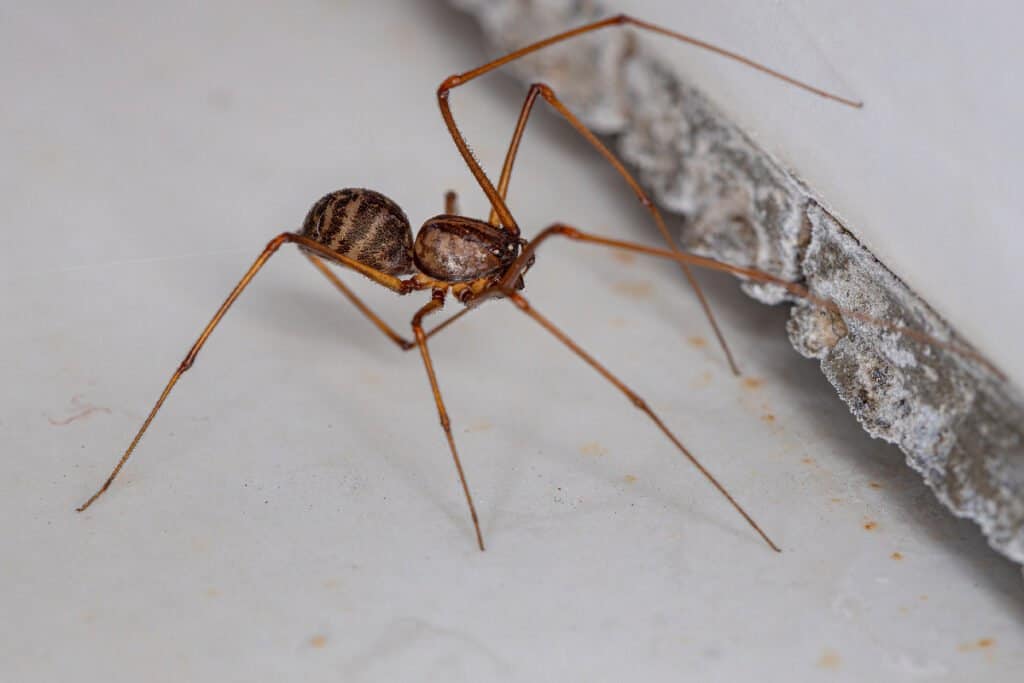
When they attack, spitting spiders “spit” a sticky substance at their victim, immobilizing it.
©iStock.com/ViniSouza128
The spitting spider has a light brown or yellow coloring with black marks scattered around its body and legs.
Spitting spiders do not build webs like most other spiders. Instead, they wait for prey to come close enough before they attack. When they attack, they “spit” a sticky substance at their victim, immobilizing it. Once the target is immobile, the spider will bite it and inject venom. This venom liquefies the victim’s insides so the spider can drink them.
These spiders are commonly found all over the world in areas with high humidity, such as near swamps or rivers. Interestingly enough, these spiders are also known to be attracted to light sources at night. So, you might find them near your porch or inside your home.
This spider’s venom is not harmful to humans, so there is no need to worry if you are bitten. However, their bites can be painful, so it is best to avoid them.
These spitting spiders reproduce by laying eggs, which hatch into baby spiders called “spiderlings.” The female lays her eggs inside a silken sac and guard them until they hatch, which is about two weeks. Once the spiderlings hatch, they climb onto their mother’s back. She carries them around for several days until they are old enough to fend for themselves. After that point, the young spiders start building their own webs to catch prey.
The Brown Recluse Spider (Loxosceles reclusa)

This notorious spider is brown in color and has a violin-shaped marking on its back.
©Physics_joe/Shutterstock.com
The brown recluse spider is quite small, although intimidating. It typically measures between 1/4 and 1/2 an inch in length. It is brown in color and has a violin-shaped marking on its back.
As its name suggests, this spider is reclusive by nature, preferring to stay hidden in dark corners and crevices. It is most commonly found in the western region of the United States.
The brown recluse spider feeds primarily on insects, such as flies, mosquitos, moths, and beetles. It can survive on very little food if necessary.
When mating, the male will spin a web for the female to lay her eggs on. The female can lay up to 50 eggs at a time, which hatch after about two weeks. Baby recluse spiders are white or light yellow when they first emerge but quickly darken as they mature.
The brown recluse spider is one of the more venomous spiders in Utah. If you come across one, you should step away. Thankfully, although this spider is venomous, it does not inject enough toxin to cause any lasting harm to humans. Instead, you can expect symptoms such as muscle pain and skin damage. Nevertheless, you should seek medical attention right away when you suspect a brown recluse spider has bitten you.
The Wolf Spider (Lycosidae)

These spiders are active hunters that do not build webs to trap prey. Instead, they rely on quick reflexes and excellent eyesight, like a
wolf
.
©Vida Shams/Shutterstock.com
Wolf spiders are one of the most common spiders in North America. They are easily recognizable due to their large size and unique appearance. Wolf spiders can range in size from 1/2 an inch to 2 inches in length and are typically dark brown or black. They have long legs and hairy bodies, making them appear intimidating at first glance. However, despite their rather scary appearance, wolf spiders are pretty harmless to humans.
In terms of behavior, wolf spiders are very active hunters that do not build webs to trap prey. Instead, they rely on quick reflexes and excellent eyesight to capture prey, like a wolf. They are primarily nocturnal creatures but can also be active during the day.
Wolf spiders typically live in wooded areas or fields with plenty of vegetation to hide in. They are also found near houses, as they like to hunt insects that come close to these areas.
When it comes to reproductive habits, the females carry their egg sacs until the eggs hatch. Once the spiderlings hatch, they climb onto their mother’s back until they are old enough to fend for themselves.
The Hobo Spider (Eratigena agrestis)
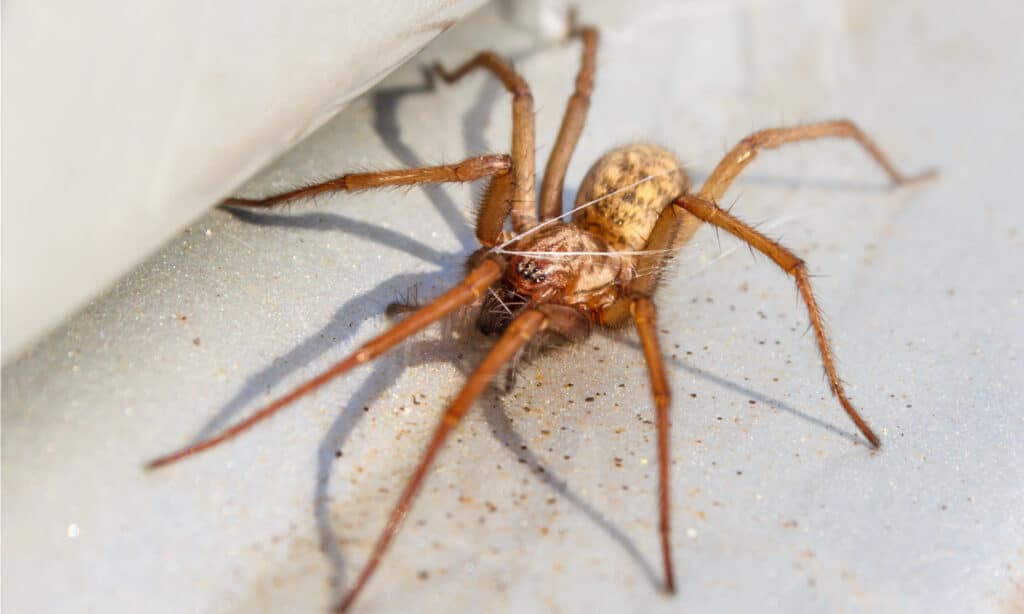
Hobo spiders
are brown or dark gray in color and have a distinctive pattern of chevron-shaped markings on their abdomen.
©Andrew Balcombe/Shutterstock.com
The hobo spider is a species found in many parts of the world, including Utah. The hobo spider is a small to medium-sized spider, typically measuring up to half an inch long. The females are slightly larger than the males. They are brown or dark gray in color and have a distinctive pattern of chevron-shaped markings on their abdomen.
Hobo spiders are shy and reclusive creatures that build their webs in hidden locations, such as under rocks or crevices. Although they are not considered aggressive, hobo spiders will bite if they feel threatened. Thankfully, their bites are not venomous to humans. With that said, a bite can potentially cause painful swelling and irritation. If you are allergic to spider venom, you should seek medical attention right away.
Hobo spiders mate in late summer or early fall, and females can lay up to 100 eggs at a time. The eggs hatch after about two weeks, and the young spiders mature into adults within one year. Hobo spiders are fascinating creatures that play an essential role in our ecosystem.
The Golden Huntsman Spider (Sparassidae)
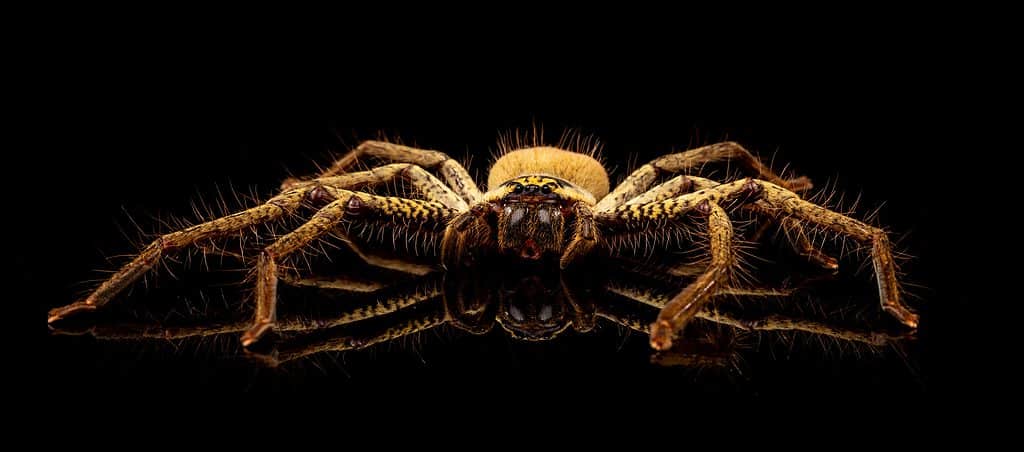
Adult golden huntsman spiders can reach lengths of between 2-3 inches!
©Heather Ruth Rose/Shutterstock.com
The golden huntsman spider, also called the giant crab spider, is a relatively huge species commonly spotted in Utah. Adult golden huntsman spiders can reach lengths of between 2-3 inches! They are brown or reddish-brown in color, with darker markings on their abdomen.
These spiders are relatively fast runners, and some people may find them to be aggressive. The giant crab spider gets its name from its ability to walk sideways. It is found in various habitats, including forests, woodlands, and urban areas. These spiders typically build their webs in dark places, such as under rocks or logs.
Golden huntsman spiders are nocturnal hunters and often enter homes in search of food. They primarily eat insects but have been known to eat small lizards and mammals if given the opportunity.
When reproducing, the female lays up to 200 eggs inside a silken sac before dying. The baby spiders will hatch after about two weeks and be independent shortly afterward.
If you come across a golden huntsman spider, beware, as this spider is venomous. However, their venom won’t do any lasting damage to humans. If you are bitten, expect quite a bit of pain, and make sure to get some medical attention!
The Camel Spider (Solifugae)
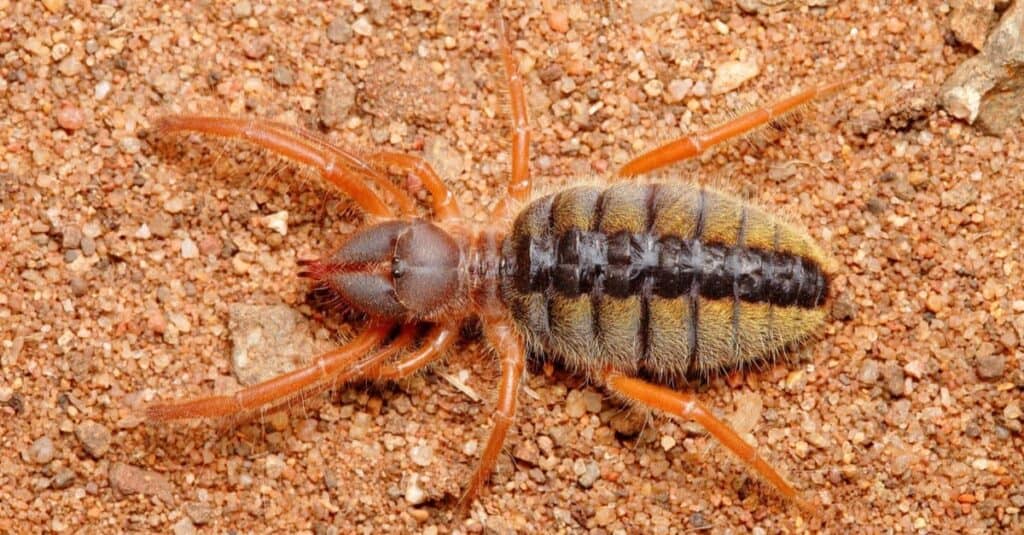
Camel spiders
are known for their aggressive behavior and often attack humans and animals if they feel threatened or intimidated.
©Ondrej Michalek/Shutterstock.com
The camel spider is a giant, hairy spider found in regions worldwide, including Utah. They are typically brown or tan in appearance and can grow up to 3 inches long. In some cases, they have been known to grow up to 6 inches! At first glance, these spiders may look like they have 10 legs, but the front two “legs” are actually pedipalps that the spider uses for sensory purposes.
Camel spiders are known for their aggressive behavior and often attack humans and animals if they feel threatened or intimidated. These spiders typically make their homes in burrows underground, where they build webs to catch their prey. A camel spider’s diet consists mainly of insects, but they have also been known to eat small mammals and reptiles.
Camel spiders mate during summer, and females can lay up to 200 eggs during the breeding season. Baby camel spiders are born alive, not in eggs, and most can fend for themselves almost immediately after birth.
While these camel spiders may look intimidating in size, they are not venomous and not harmful to humans.
The Running Crab Spider (Philodromidae)

Running crab spiders are particularly small.
©Vinicius R. Souza/Shutterstock.com
The running crab spider is tiny, measuring only 0.2 inches or 5 mm in length. They are brown or gray in color and can have a distinctive crab-like shape, hence their common name.
These spiders are speedy runners and can catch their prey very quickly. They live in various habitats in Utah, including forests, grasslands, and gardens. They build their webs close to the ground and often hide amongst vegetation.
Running crab spiders are interesting creatures because of their hunting behavior. Rather than creating a web to catch their prey, they actively hunt down insects. They can also camouflage their bodies to match their surroundings, making them difficult to spot! Their diet consists mainly of small insects such as flies and moths. However, they will also eat other spiders if given the opportunity.
Mating season for these spiders usually takes place in the springtime. After mating, the female lays her eggs inside a silken sac, which she attaches to vegetation. The eggs hatch after around two weeks, and the young spiderlings stay with their mother for a few days before venturing out on their own.
Running crab spiders are equipped with enough venom to kill their prey, but this is not enough to cause any harm to humans. In fact, the bite itself is usually not even strong enough to pierce the skin. However, if you are bitten, keep an eye on the wound for any signs of an allergic reaction.
The Fishing Spider (Dolomedes)
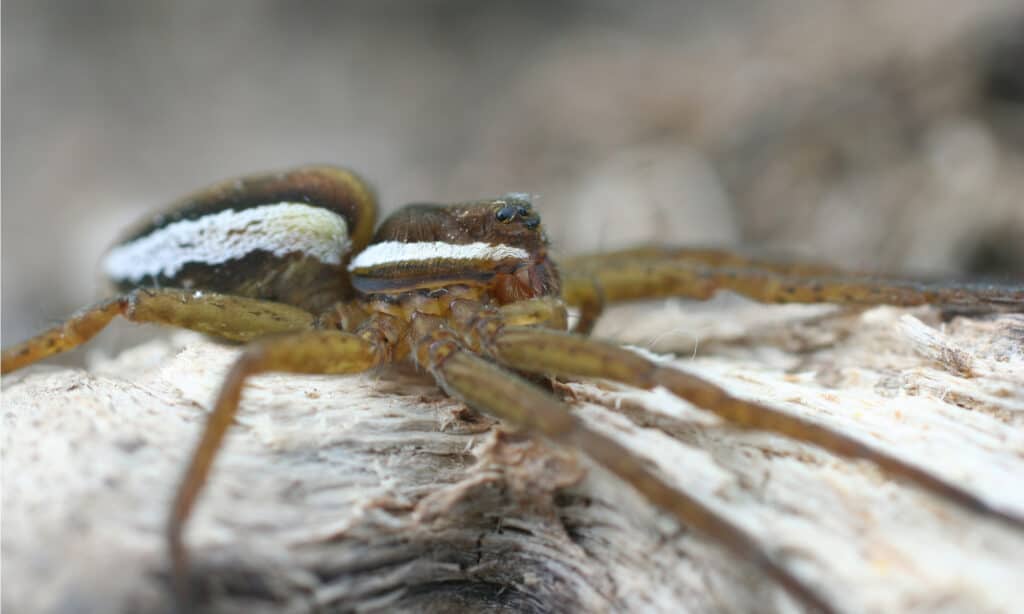
This ability to walk on water is due to hydrophobic hairs on their legs, which repel water and allow them to “skate” across the surface.
©Oleg Nikonov/Shutterstock.com
The fishing spider is another spider species you’ll come across in Utah. The female is generally between 0.6 to 1 inch in length, and the male is a bit smaller at around 0.27 to 0.5 inches. They are brown or black in color and have long legs that enable them to move quickly across water surfaces.
This ability to walk on water is made possible by the hydrophobic hairs on their legs, which repel water and allow them to “skate” across the surface. These spiders are also excellent swimmers and have been known to dive beneath the water’s surface in pursuit of prey.
As expected, fishing spiders typically live near bodies of water, such as ponds, lakes, and streams. Their diet consists mainly of small fish, tadpoles, and other aquatic insects. Fishing spiders are one of the few species that actively hunt their prey. Most spiders wait for prey to come within range before pouncing.
When it comes time to mate, males often give gifts of prey items wrapped in silk to potential mates. If the female accepts the presents, she allows the male to approach her for mating. After mating, the female lays eggs (usually around 1,000) inside a silken sac, before attaching it to vegetation near water. The baby spiders hatch after approximately two weeks, at which point they begin hunting for food on their own.
The photo featured at the top of this post is © iStock.com/Sheril Kannoth
Thank you for reading! Have some feedback for us? Contact the AZ Animals editorial team.






